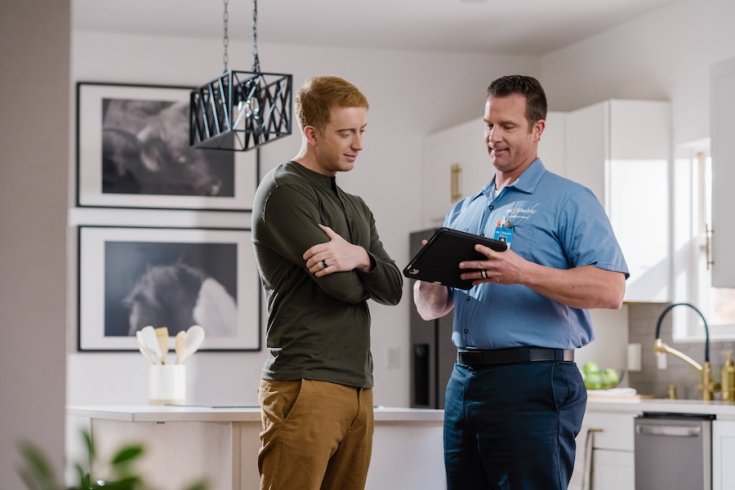What should I do if my circuit breaker keeps tripping?
A tripped breaker is your panel’s way of preventing damage or danger from too much current. If it happens once, it might not be a big deal, but if it keeps happening, it’s likely due to a short circuit, ground fault, or overloaded circuit. Don’t keep flipping it back on without finding the root cause. Persistent issues need professional electrical repair to protect your home.
Is aluminum wiring dangerous?
Aluminum wiring poses higher fire risks than copper because of its tendency to expand and contract with temperature changes. Over time, this movement can loosen connections and lead to arcing or overheating. If your home was built between the mid-1960s and mid-1970s, it's smart to have it inspected to see whether upgrades are needed.
What’s the difference between a fuse and a circuit breaker?
Fuses are one-time-use devices that melt when overloaded, while breakers are reusable switches that flip off when a fault is detected. Breakers are more common in modern homes because they’re easier to reset and maintain. If your system still uses fuses, it might be a sign that your panel needs an upgrade to meet today’s standards.
Why does one outlet not work while the others are fine?
Sometimes, a single outlet can lose power from a loose wire, internal damage, or a tripped GFCI circuit further upstream. Even if that outlet isn’t GFCI-protected, it could be connected to one that is. This kind of issue can be confusing and might affect other outlets on the same line, so it’s worth getting checked.
How can I tell if my electrical panel is outdated?
If your panel is over 25 years old, doesn’t support 100 amps or more, or you notice signs like corrosion, heat marks, or humming sounds, it’s likely outdated. An older panel may not be able to handle modern energy use safely, especially if you’ve added large appliances, a hot tub, or an EV charger in recent years.
What are the signs of faulty wiring?
Buzzing from switches, frequent tripped breakers, warm outlets, flickering lights, and burning odors are all red flags that your wiring might be damaged or worn out. Faulty wiring is one of the leading causes of residential electrical fires, so don’t wait if you notice any of these symptoms—get an inspection scheduled right away.
How often should I schedule electrical maintenance?
A full system check every 3 to 5 years is usually enough for most homes. But if you live in an older house, are planning renovations, or have high power usage, more frequent inspections are wise.
Is it okay to plug multiple power strips into one outlet?
Plugging multiple power strips into one outlet is never recommended. It can easily overload the circuit and increase the risk of sparks, overheating, or fire. If you’re running out of outlets, the safest fix is to have more installed by a qualified electrician.
Can a faulty light switch cause a fire?
Yes, it can. If a switch is cracked, loose, or sparking, or if you hear a buzzing sound when it's flipped, there may be arcing inside. Even a small arc can lead to overheating and, eventually, a fire if left ignored. Don’t ignore faulty switches.
Should I be worried about outlets that spark?
Small, quick sparks when you plug something in aren’t always dangerous. They can happen when metal prongs quickly make contact with energized terminals. But large sparks, persistent arcing, or a burning smell mean there’s a deeper issue that could involve damaged wires, moisture, or worn components.
What is whole-home surge protection, and do I need it?
Whole-home surge protection helps prevent sudden voltage spikes from damaging your electronics and wiring. It's installed at your electrical panel and offers a much higher level of safety than just using power strip surge protectors. For many homes, especially in storm-prone or rural areas, it’s a smart investment.
Can I upgrade my panel without rewiring the whole house?
Yes. If your existing wiring is in good shape and meets the current code, you can upgrade the panel on its own. That said, a panel upgrade is a good time to evaluate the overall condition of your electrical system and consider making other updates while you’re already doing work.
How do I know if my home is grounded properly?
One quick clue is whether your outlets have three prongs instead of two. But even if they do, grounding may not be present or reliable without inspection. Ungrounded systems can increase the risk of shocks or fire. An electrician can use tools to confirm whether your system is safely grounded and up to code.
Are buzzing lights a serious problem?
A buzzing light might be caused by a bulb that’s loose, the wrong type for the fixture, or incompatible with a dimmer switch. But it can also signal an electrical load issue or faulty wiring. If changing the bulb doesn’t help, the buzzing should be evaluated by a professional.
Can old wiring affect energy efficiency?
Yes, aging or outdated wiring can increase resistance in your electrical system and cause inefficiency, overheating, and premature wear on appliances. In some cases, it may also leak current. Replacing old wiring not only increases safety but can also help your system deliver power more reliably and efficiently.
Is it safe to install smart home devices without help?
Some devices, like plug-in smart outlets, are simple to set up. But anything that connects directly to your wiring can pose safety risks if installed incorrectly. It's always best to consult professionals who are experienced in both smart technology and electrical repair.
How can I tell if an outlet is GFCI-protected?
Look for the "Test" and "Reset" buttons on the face of the outlet, which means it’s GFCI-equipped. If the outlet is near water, like in a kitchen or bathroom, it should be GFCI-protected by code. Keep in mind that one GFCI outlet can protect others on the same circuit even if they don’t have visible buttons.
Why do I lose power in just one room, not the whole house?
This type of outage means a breaker tripped, a GFCI tripped upstream, or a fault occurred in that room’s circuit. It could also be a loose wire or a damaged outlet somewhere in the chain. Power loss in one room isn’t always serious, but if it happens repeatedly, it should be addressed by someone familiar with full electrical service work.
What’s the risk of ignoring a minor electrical issue?
That strange smell, buzzing switch, or occasional flickering might seem small, but electrical systems rarely fix themselves. Problems can escalate fast and sometimes without warning. Ignoring them increases the risk of damage to your home, appliances, or a fire.
What’s the best way to prepare for a power outage?
Make sure you have working flashlights, a backup battery for phones, and a plan for preserving food. Surge protectors help guard electronics and portable generators, and standby generators can power essentials like the fridge and lights. For extended outages, a permanent generator setup may be worth considering.
Is it possible to add outlets without tearing into walls?
Yes, in certain cases. Surface-mounted conduit, wireless systems, or strategic placement near existing wiring can minimize the need for major demolition. A skilled electrician can evaluate your home and offer options that fit your layout and budget.
Why do my dimmer switches buzz or hum?
Buzzing usually means your dimmer switch isn’t compatible with your bulbs, especially with newer LED lights. Old dimmers were designed for incandescent bulbs and don’t regulate voltage the same way. Upgrading to an LED-compatible dimmer usually solves the issue and gives you better light control.








